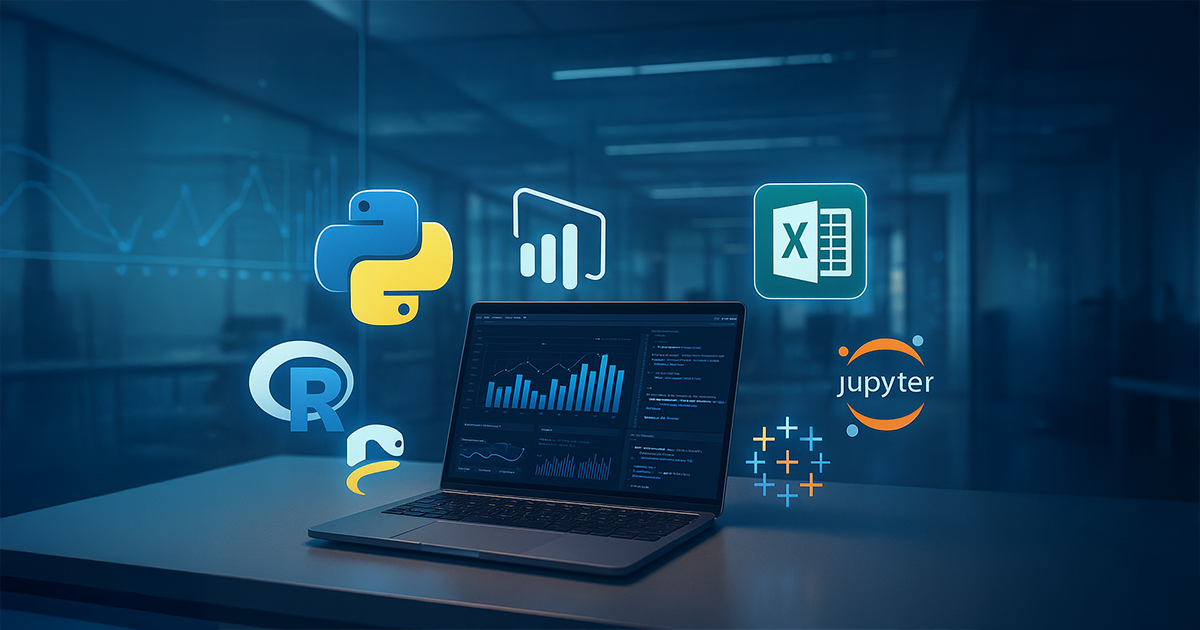
In 2025, data isn’t just a buzzword, it’s the driving force behind every major decision. Each click, swipe, and transaction generates insights that shape business strategy, product development, and customer experience. Professionals who can decode that raw data into action are the ones winning. But with data pouring in from various sources, selecting the right tools becomes key.
Whether you are an aspiring analyst, a data scientist, or a decision-maker, your choice of tools in 2025 will determine how fast, smart, and accurate your outcomes are.
Why Choosing the Right Data Science Tools Matters
The data science field is not one-size-fits-all. Different roles, from data analysts and engineers to business intelligence developers, all require different tools. Aligning your skill set with the tools in demand can be a career (and business) game-changer.Choosing the right tools can help you:
Increase job opportunities in a competitive market
- Save time and reduce errors
- Streamline repetitive tasks and focus on strategic planning
- Effectively manage complex data sets with accuracy
- Integrate seamlessly with your other preferred platforms
- Increase job opportunities in a competitive market
Top Data Science Tools You Must Know in 2025
Here are the key tools shaping the future of data science this year:
- Python: The most widely used programming language, Python’s ease of use and versatility make it ideal for a range of projects, from data dashboards to machine learning models.
- Advanced Excel: Excel remains a powerhouse for complex analysis and dashboard creation, with its latest version bringing AI-assisted functions, real-time collaboration, and automation.
- SQL: Structured Query Language (SQL) remains the backbone of database management, enabling users to query, manipulate, and manage large datasets, which allows for fast data extraction and transformation.
- Power BI: A popular data visualization and business intelligence tool, Power BI helps organizations gain deeper insights, track key performance indicators, and make informed decisions.
- Tableau: A leading data visualization software, Tableau offers drag-and-drop functionality, impressive graphics, and the ability to present data in a compelling narrative.
- Pandas: A go-to library for versatile data manipulation in Python, Pandas is essential for data cleaning, transformation, and analysis.
- Numpy: Numpy is the foundation of numerical computing in Python, providing fast, efficient arrays and matrices, essential for scientific computing and data analysis.
- Power Query: Power Query enables you to connect, merge, and transform data seamlessly within Excel and Power BI.
Category-wise Breakdown of Tools
To make your learning path easier, here’s a simplified breakdown of the top data science tools in 2025, organized by category to help you see where they fit in your data workflow.
| Category | Tool |
| Programming and Scripting | Python, Pandas |
| Data Query and Management | SQL |
| Business Intelligence | Power BI, Tableau |
| Data Manipulation ( Python) | Numpy, Power Query |
| Data Preparation and Cleaning | Power Query |
| Spreadsheet Analysis | Advanced Excel |
Tips to Choose the Right Tool for Your Career Path
Different data tools serve different purposes, and not every tool suits every career. Your choices will shape your learning experience, skills, and employability. Here’s how you can choose the right tools that align with your current level and your future aspirations.
- Begin with the Basics: Start with user-friendly platforms like Excel and Power BI. These tools offer a solid foundation in data organization, visualization, and decision-making, ideal for beginners.
- Align Your Tools With Your Career Goals:
- Business Intelligence Analyst → Power BI, Tableau, Excel
- Data Scientist → Python, Pandas, Numpy, SQL
- Data Engineer → SQL, Python
- Focus on High-Demand Skills: Focus more on the tools frequently mentioned in job descriptions, which often include Python, SQL, and Power BI.
- Become Proficient in One Tool per Category: Focus on mastering a single tool for each task, like Excel for spreadsheet analysis, Python for programming, and Power BI for dashboards.
- Think Long Term: Choose tools that keep up with current industry trends that integrate AI, automation, and real-time collaboration (like Excel + Power Query or Power BI).
Future Outlook: What’s Next in Data Science Tools?
The data science landscape is shifting fast with automation, real-time collaboration, and AI integration. Tools such as Excel, Power BI, and Python libraries are evolving with smart features that automate complex analysis and reduce manual work.
Low-code and no-code platforms now even allow non-technical users to interact with data independently, reducing the workload of developers. Meanwhile, hybrid tools such as Python integration within Power BI are becoming standard across workflows.
With rising concerns around data privacy, the demand for cloud-based, compliance-ready solutions is growing with each passing day. The future belongs to tools that combine power, simplicity, and security, without compromising user control.
Upgrade Your Skills—Start Learning Now!
Ready to build a data-driven career? SkillSpaark’s Data Science Course is designed to take you from beginner to job-ready professional with expert-led mentorship, personalized career guidance, and structured, hands-on modules.
Whether you’re making a career switch or upgrading in your current role, this course gives you the tools, support, and industry relevance to stand out in a competitive job market.
Launch your career in data with SkillSpaark’s Data Science course and start building the future you deserve.
Python, SQL, and Power BI top the list due to their versatility, demand, and wide usage.
Absolutely. Python continues to thrive due to its simplicity, massive library ecosystem, and machine learning capabilities.
Excel is the best starting point, followed by Power BI and SQL. Python can be introduced gradually.
Yes. Many freelance projects and remote roles list these tools as requirements.
Absolutely. The course requires no prior experience as our step-by-step modules make learning Python and SQL beginner-friendly and application-focused.
Absolutely. SkillSpaark offers live mentor support, doubt-clearing sessions, and community support to keep your progress on track.
Yes. The tools like Tableau, Python, SQL, and Excel are all based on current industry demand and trends.
It offers practical training, real-world projects, mentorship, and job assistance, all tailored for today’s data-driven careers.






